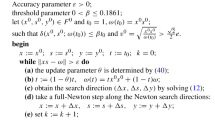Abstract
Interior–point algorithms are among the most efficient techniques for solving complementarity problems. In this paper, a procedure for globalizing interior–point algorithms by using the maximum stepsize is introduced. The algorithm combines exact or inexact interior–point and projected–gradient search techniques and employs a line–search procedure for the natural merit function associated with the complementarity problem. For linear problems, the maximum stepsize is shown to be acceptable if the Newton interior–point search direction is employed. Complementarity and optimization problems are discussed, for which the algorithm is able to process by either finding a solution or showing that no solution exists. A modification of the algorithm for dealing with infeasible linear complementarity problems is introduced which, in practice, employs only interior–point search directions. Computational experiments on the solution of complementarity problems and convex programming problems by the new algorithm are included.
Similar content being viewed by others
References
Andreani, R., Birgin, E.G., Martínez, J.M., Schuverdt, M.L.: Augmented lagrangian methods under the constant positive linear dependence constraint qualification. Math. Program. 111, 5–32 (2008)
Andreani, R., Friedlander, A., Santos, S.A.: On the resolution of the generalized nonlinear complementarity problem. SIAM J. Optim. 12, 303–321 (2001)
Andreani, R., Júdice, J., Martinez, J.M., Patrício, J.: On the natural merit function for solving complementarity problems. Math. Program. (to appear)
Birgin, E.G., Martinez, J.M., Raydan, M.: Nonmonotone spectral projected gradient methods on convex sets. SIAM J. Optim. 10, 1196–1211 (2000)
Birgin, E.G., Martinez, J.M., Raydan, M.: Algorithm 813 SPG: software for convex–constrained optimization. ACM Trans. Math. Softw. 27, 340–349 (2001)
Birgin, E.G., Martinez, J.M., Raydan, M.: Inexact spectral projected gradient methods on convex sets. IMA J. Numer. Anal. 23, 539–559 (2003)
Brooke, A., Kendrick, D., Meeraus, A., Raman, R.: GAMS—A User’s Guide. GAMS Development Corporation (1998)
Cottle, R., Pang, J., Stone, R.: The Linear Complementarity Problem. Academic, New York (1992)
Dennis, J.E., Schnabel, R.B.: Numerical Methods for Unconstrained Optimization and Nonlinear Equations. Prentice Hall Series in Computational Mathematics, Englewood Cliffs, New Jersey (1983)
Facchinei, F., Pang, J.S.: Finite-Dimensional Inequalities and Complementarity Problems. Springer, New York (2003)
Fernandes, L., Friedlander, A., Guedes, M.C., Júdice, J.: Solution of a general linear complementarity problem using smooth optimization and its applications to bilinear programming and LCP. Appl. Math. Optim. 43, 1–19 (2001)
Fernandes, L., Júdice, J., Figueiredo, I.: On the solution of a finite element approximation of a linear obstacle plate problem. Int. J. Appl. Math. Comput. Sci. 12, 27–40 (2002)
Ferris, M.C., Kanzow, C., Munson, T.S.: Feasible descent algorithms for mixed complementarity problems. Math. Program. 86, 475–497 (1999)
Ferris, M.C., Munson, T.S.: Interfaces to PATH 3.0: design, implementation and usage. Comput. Optim. Appl. 12, 207–227 (1999)
Fischer, A.: New constrained optimization reformulation of complementarity problems. J. Optim. Theory Appl. 12, 303–321 (2001)
Floudas, C.A., Pardalos, P.M.: A Collection of Test Problems for Constrained Global Optimization Algorithms, vol. 455. Springer, New York (1990)
Gay, D.M.: Electronic Mail Distribution of Linear Programming Test Problems. Technical report, Mathematical Programming Society COAL Newsletter (1985)
Golub, G., Van Loan, C.: Matrix Computations. Johns Hopkins University Press, Baltimore (1983)
Gould, N.I., Orban, D., Toint, P.: General CUTEr Documentation. Technical Report TR/PA/02/13, CERFACS (2003)
Haslinger, J., Hlavacek, I., Necas, J.: Numerical methods for unilateral problems in solid mechanics. In: Ciarlet, P.G., Lions, J.L. (eds.) Handbook of Numerical Analysis, vol. IV. North–Holland, Amsterdam (1996)
Intel Corporation: Intel Fortran Compiler User’s Guide (2002)
Júdice, J., Raydan, M., Rosa, S., Santos, S.: On the solution of the symmetric eigenvalue complementarity problem by the spectral projected gradient algorithm. Numer. Algorithms 45, 391–407 (2008)
Kikuchi, N., Oden, J.T.: Contact Problems in Elasticity: A Study of Variational Inequalities and Finite Elements. SIAM, Philadelphia (1988)
Kojima, M., Megiddo, N., Noma, T., Yoshise, A.: A unified approach to interior-point algorithms for linear complementarity problems. IN: Lecture Notes in Computer Science, vol. 538. Springer, Berlin (1991)
Li, D.-H., Fukushima, M.: Derivative–free line search and global convergence of Broyden–like method for nonlinear equations. Optim. Methods Softw. 13, 181–201 (2000)
Murtagh, B.A., Saunders, M.A.: MINOS 5.1 User Guide. Technical Report, Department of Operations Research, Stanford University (1987)
Murty, K.: Linear Complementarity, Linear and Nonlinear Programming. Heldermann, Berlin (1988)
Nocedal, J., Wright, S.: Numerical Optimization. Springer, New York (2000)
Ortega, J.M., Rheinboldt, W.C.: Iterative Solution of Nonlinear Equations in Several Variables. SIAM, Philadelphia (2000)
Ostrowski, A.M.: Solution of Equations and Systems of Equations. Academic, New York (1967)
Patrício, J.: Algoritmos de Pontos Interiores para Problemas Complementares Monótonos e Suas Aplicações. PhD thesis, Universidade de Coimbra, Portugal (2007). In Portuguese
Portugal, L.F., Resende, M.G.C., Veiga, G., Júdice, J.J.: A truncated primal-infeasible dual-feasible network interior point method. Networks 35, 91–108 (2000)
Schwetlick, H.: Numerische Lösung Nichtlinearer Gleichungen. Deutscher Verlag der Wissenschaften, Berlin (1979)
Solodov, M.V.: Stationary points of bound constrained minimization reformulations. J. Optim. Theory Appl. 94, 449–467 (1997)
Vanderbei, R.J.: LOQO: an interior point code for quadratic programming. Optim. Methods Softw. 12, 451–484 (1999)
Vanderbei, R.J.: LOQO’s User Manual, Version 4.05. School of Engineering and Applied Science, Princeton University (2000)
Wright, S.: Primal–Dual Interior–Point Methods. SIAM, Philadelphia (1997)
Wright, S.J., Ralph, D.: A superlinear infeasible interior-point algorithm for monotone complementarity problems. Math. Oper. Res. 21, 815–838 (1996)
Author information
Authors and Affiliations
Corresponding author
Rights and permissions
About this article
Cite this article
Andreani, R., Júdice, J.J., Martínez, J.M. et al. A projected–gradient interior–point algorithm for complementarity problems. Numer Algor 57, 457–485 (2011). https://doi.org/10.1007/s11075-010-9439-0
Received:
Accepted:
Published:
Issue Date:
DOI: https://doi.org/10.1007/s11075-010-9439-0




